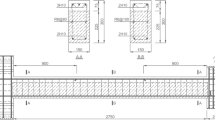Abstract
Steel–concrete composite joints possess higher bearing capacity, initial stiffness and redundancy than bare steel joints. The configuration of beam-column connection would influence the behavior of composite joints, such as rigidity, rotation capacity and so on. In this paper, the test of two fully welded rigid composite joints and two flush endplate semi-rigid composite joints was introduced. The loading conditions in the tests involved sagging moment and hogging moment. The mechanical behavior of composite joints under bending moment was studied in detail, especially on the influence of connection configuration. The test results indicated that the experimental phenomena and failure mode of fully welded composite joint and flush endplate composite joint under hogging moment were similar to each other. The buckling of bottom flange of steel beam determined the behavior of composite joint under hogging moment, such as initial stiffness and bending strength. It indicated that using flush endplate connection instead of fully welded connection in composite joints had little influence on the behavior of the joint under service loads if the failure mode of joints is governed by the same component. Four models for moment-rotation relation of composite joints are compared with experimental results. Based on the comparison, a new combination model of power function expression and linear expression is developed. With proper optimum shape parameter and descending stiffness, the new model could present the moment-rotation relation of composite joints, regardless of connection configuration or loading condition.


























Similar content being viewed by others
References
Attigobe, E., & Morris, G. (1991). Moment-rotation functions for steel connections. Journal of Structural Engineering, ASCE, 117(6), 1703–1718.
Bernuzzi, C., Zandonini, R., & Zanon, P. (1996). Experimental analysis and modeling of semi-rigid steel joints under cyclic reversal loading. Journal of Constructral Steel Research, 38(2), 95–123.
Calado, L., Proenca, J. M., Espinha, M., et al. (2013). Hysteretic behavior of dissipative welded fuses for earthquake resistant composite steel and concrete frames. Steel and Composite Structures, 14(14), 547–569.
Eurocode 3. (2003). Eurocode 3: Design of Steel Structures, Part 1.8: Design of Joints, prEN1993-1-8, European Committee for Standardization, Brussels, Belgium.
Eurocode 4. (2004). Eurocode 4: Design of composite steel and concrete structures, Part 1.8: Design of joints, prEN1994-1-1, European Committe for Standardization, Brussels, Belgium.
Eurocode 8. (2004). Eurocode 8: Design of structures for earthquake resistance, Part 1: General rules, seismic actions and rules for buildings, prEN1998-1, European Committe for Standardization, Brussels, Belgium.
Fu, F., Lam, D., & Ye, J. Q. (2008). Modelling semi-rigid composite joints with precast hollow core slabs in hogging moment region. Journal of Constructional Steel Research, 64(12), 1408–1419.
Gil, B., & Bayo, E. (2008). An alternative design for internal and external semi-rigid composite joints Part I: Experimental research. Engineering Structures, 30(1), 218–231.
Green, T., Leon, T. R., & Rassati, G. A. (2004). Bidirectional tests on partially restrained, composite beam-to-column connections. Journal of Structural Engineering, 130(2), 320–327.
Huang, X., Shi, W. L., & Ye, Z. M. (2010). Moment-rotation relation research on beam-to-column compsite joints. Progress in Steel Building Structure, 12(2), 13–22 (in Chinese).
Jaspart, J. P., & Weynand, K. (2016). Design of joints in steel and composite structures. ECCS eurocode design manuals. New York: Wiley.
Li, W., & Han, L. H. (2011). Seismic performance of CFST column to steel beam joints with RC slab. Journal of Constructional Steel Research, 67(1), 127–139.
Liu, J., & Astaneh-Asl, A. (2004). Moment-rotation parameters for composite shear tab connections. Journal of Structural Engineering, 130(9), 1371–1380.
Loh, H. Y., Uy, B., & Bradford, M. A. (2006). The effects of partial shear connection in composite flush end plate joints Part I: Experimental study. Journal of Constructional Steel Research, 62(4), 378–390.
Nie, J. G., Qin, K., & Cai, C. S. (2008). Seismic behavior of connections composed of CFSSTCs and steel-concrete composite beams experimental study. Journal of Constructional Steel Research, 64(10), 1178–1191.
Richard Liew, J. Y., Teo, T. H., Shanmugam, N. E., et al. (2000). Testing of steel-concrete composite connections and appraisal of results. Journal of Constructional Steel Research, 56, 117–150.
Shi, W. L., Li, G. Q., Xiao, Y., & Ye, Z. M. (2008). Cyclic loading tests on composite beam-to-column joints with semi-rigid connections. Journal of Building Structures, 29(5), 57–66 (in Chinese).
Shi, Y. J., Su, D., & Wang, Y. Q. (2006). An experimental study on the seismic performance of beam-to-column joints in steel frames with the effect of concrete slabs considered. Journal of Building Structures, 39(9), 26–31 (in Chinese).
Simoes da Silva, L., Simoes, R. D., & Cruz, P. (2001). Experimental behavior of end-plate beam-to-column composite joints under monotonical loading. Engineering Structures, 23, 1383–1409.
Wang, J. F., Han, L. H., & Uy, B. (2009). Behavior of flush end plate joints to concrete-filled steel tubular columns. Journal of Constructional Steel Research, 65(4), 925–939.
Wang, J. F., Zhang, H. J., & Jiang, Z. (2016). Seismic behavior of blind bolted end plate composite joints to CFTST columns. Thin-Walled Structures, 108, 256–269.
Xiao, Y., Choo, B. S., & Nethercot, D. A. (1994). Composite connections in steel and concrete I: Experimental behavior of composite beam-column-connection. Journal of Construction Steel Research, 31(5), 3–30.
Yang, B., Tan, K. H., & Xiong, G. (2015). Behaviour of composite beam–column joints under a middle-column-removal scenario: Component-based modelling. Journal of Constructional Steel Research, 104, 137–154.
Yu, J., & Tan, K. H. (2013). Structural behavior of RC beam-column subassemblages under a middle column removal scenario. Journal of Structural Engineering ASCE, 139(2), 233–250.
Acknowledgements
The project is supported by National Key R&D Program of China (2016YFC0701203), China Postdoctoral Science Foundation (2017M622965), Chongqing Postdoctoral Special Foundation (Xm2017095), Scientific Research Program Funded by Shaanxi Provincial Education Department (17JK1154) and Xijing University Special Foundation (XJ17T07), which are gratefully acknowledged.
Author information
Authors and Affiliations
Corresponding author
Rights and permissions
About this article
Cite this article
Gao, S., Guo, L. Study on the Influence of Connection Configuration on Composite Joints. Int J Steel Struct 18, 1048–1062 (2018). https://doi.org/10.1007/s13296-018-0045-7
Received:
Accepted:
Published:
Issue Date:
DOI: https://doi.org/10.1007/s13296-018-0045-7




